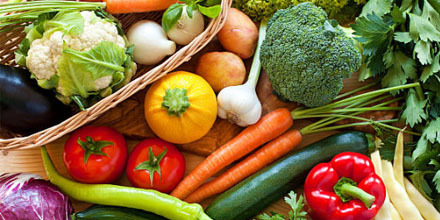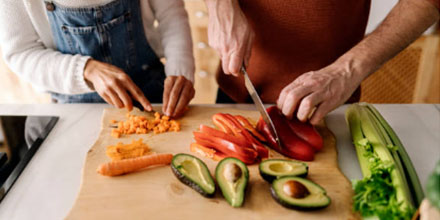
From Heart Health Club Nutritionist, Chloe Steele
Most of us don’t eat enough vegetables. In fact, in the most recent figures on dietary behaviour to come out of the Australian Bureau of Statistics, only 8.7% of Australian adults consume the recommended serves of vegetables per day 1. A serving of vegetables equates to approximately half a cup of cooked green, orange, or red vegetables such as carrots, broccoli, or pumpkin and a cup of leafy green or raw vegetables such as lettuce, chard, or rocket. The Australian Institute for Health and Welfare recommends that women over the age of 18 eat 5 servings per day and males consume 6 servings, however this may be a conservative estimate especially when looking at vegetable intake for heart health 2.
Why are vegetables so important for heart health?
High intakes of fruits and vegetables have been shown to reduce the risk of the development of heart disease. This could be due to a number of reasons 3. For example, vegetables contain high amounts of fibre, which can help you to feel fuller for longer, prevent overeating and aid weight loss 4. The consumption of vegetable juice has been shown to have beneficial effects on blood pressure and naturally occurring chemicals found in fruits and vegetables known as polyphenols, which can block dietary absorption of saturated fats, helping to maintain a good blood lipid profile 5,6. So, the more vegetables you eat, the greater the likelihood that your heart will be healthy.
Go frozen
Eating 5-6 servings per day can be a challenge for many of us for many different reasons. Increasing food and living costs means that budgets are often cut and fresh fruits and vegetables, which are often the highest priced items in the weekly shop, are substituted for food with a lower cost both monetarily and nutritionally. Frozen vegetables such as broccoli, carrots and peas are lower in price, yet we tend to view it as a less appetising alternative 7. In reality, freezing can help to retain the nutrient content and in some cases may even improve the beneficial properties vegetables have 8. Those who have overcome this negative view and consume the frozen versions have been shown on average to be closer to achieving the recommended daily intake 9.
Think about preparation

Now if you aren’t keen on eating vegetables try experimenting with recipes. There are many ways that vegetables can be prepared so maybe you just haven’t found the right method for you. For example if asparagus seems unappetising when steamed, when roasted and tossed with feta cheese, balsamic vinegar and olive oil it turns into an interesting side dish.
Turn vegetables into noodles
Making vegetable noodles or pasta has so many benefits, not only are you increasing your vegetable intake, but you are substituting out refined carbohydrates, which are associated with an increased risk for heart disease 10. Sweet potatoes, carrots, zucchini, and beetroot all make great alternatives to the pasta version and are very nutrient dense. Spiralisers are a great piece of equipment and help to make vegetable noodles quick and easy. However, if you don’t have a spiraliser then you can make pappardelle style pasta using just a peeler. These can then be used as they are or layered through a lasagne to give your dish a great nutrient boost.
Turn vegetables into chips
Cutting thin slices of beetroot, kale or Brussels sprouts and roasting them in the oven is a great way to make a healthy snack. There are so many vegetables that can be turned into chips and once cooked are hard to stop picking up and eating. If they do make it past the cooling stage, then they can also be used as a crunchy garnish for salads and pasta (the veggie version of course).
Snack on vegetables
Although eating between meals isn’t ideal, everyone is different and if snacks are the only way to get you through the day, then why not make vegetables your go to? The trick with this is to avoid what those of us in the business call a food crisis. This usually occurs when you have had such a busy day that you’ve barely eaten and suddenly you are so hungry that you can’t face preparing something healthy and instead you grab something less nutritious for instant satisfaction. Preparing vegetable crudités the night before while prepping dinner and popping them in a box in the fridge with a great hummus dip will help you make a healthier decision when it comes to snack time.
References
1. Statistics australian B of. Dietary Behaviour. Health Conditions and Risks. https://www.abs.gov.au/statistics/health/health-conditions-and-risks/dietary-behaviour/latest-release#:~:text=Three in five (62.6%25),4.1%25 did not eat vegetables. Published 2021.
2. Welfare AI of H and. Australia’s Health 2018. Vol 16.; 2018.
3. Aune D, Giovannucci E, Boffetta P, et al. Fruit and vegetable intake and the risk of cardiovascular disease, total cancer and all-cause mortality-A systematic review and dose-response meta-analysis of prospective studies. Int J Epidemiol. 2017;46(3):1029-1056. doi:10.1093/ije/dyw319
4. Zhu R, Fogelholm M, Poppitt SD, et al. Adherence to a plant-based diet and consumption of specific plant foods—associations with 3-year weight-loss maintenance and cardiometabolic risk factors: A secondary analysis of the preview intervention study. Nutrients. 2021;13(11). doi:10.3390/nu13113916
5. Chiva-Blanch G, Urpi-Sarda M, Ros E, et al. Effects of red wine polyphenols and alcohol on glucose metabolism and the lipid profile: A randomized clinical trial. Clin Nutr. 2013;32(2):200-206. doi:10.1016/j.clnu.2012.08.022
6. Zheng J, Zhou Y, Li S, et al. Effects and mechanisms of fruit and vegetable juices on cardiovascular diseases. Int J Mol Sci. 2017;18(3). doi:10.3390/ijms18030555
7. Connell PM, Finkelstein SR, Scott ML, Vallen B. Negative associations of frozen compared with fresh vegetables. Appetite. 2018;127(January):296-302. doi:10.1016/j.appet.2018.05.134
8. Çubukçu HC, Kılıçaslan NSD, Durak İ. Different effects of heating and freezing treatments on the antioxidant properties of broccoli, cauliflower, garlic and onion. An experimental in vitro study. Sao Paulo Med J. 2019;137(5):407-413. doi:10.1590/1516-3180.2019.004406082019
9. Storey M, Anderson P. Total fruit and vegetable consumption increases among consumers of frozen fruit and vegetables. Nutrition. 2018;46:115-121. doi:10.1016/j.nut.2017.08.013
10. Yu D, Shu XO, Li H, et al. Dietary carbohydrates, refined grains, glycemic load, and risk of coronary heart disease in chinese adults. Am J Epidemiol. 2013;178(10):1542-1549. doi:10.1093/aje/kwt178
